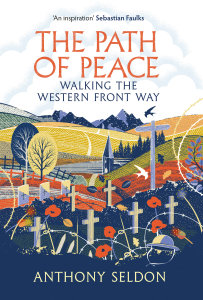Antony Seldon is a prolific author and The Path for Peace may well be his best and most enduring book. It was not just the writing. The Path for Peace documents 1000 kms, over some 40 days, in which Seldon walked along the length of the western front (as first the Germans and eventually everyone, called it) and he was at the estuary town of Nieuwpoort and looking at the North Sea. More than a long walk, it had been a pilgrimage and a search for meaning.
Seldon was enacting an old idea. Douglas Gillespie, the younger of two brothers killed in the war, had wrote to his parents that after the war there should be a path where No Man’s Land had been, ‘with paths for pilgrims on foot, and plant trees for shade, and fruit trees, so the soil should not be altogether waste. Then I would like to send every man and child in Western Europe on pilgrimage along that Via Sacra, so that they might think and learn what war means from the silent witnesses on either side’ (p.5). It was a striking and visionary idea and it captivated Seldon when he read the letter.

And yet Seldon had been on that path for years before he read the letter. Finally, he stands on the spot where his grandfather had been shot in the head and mused how as a survivor, the trauma, foreboding and anxiety had passed to his Mum and then to him. ‘I inherited these debilitating personality traits, and have never been able to transcend them. If only I could, 107 years later… leave them here, right here in these woods’ (p.257). That connection with the past and what it means in the present makes this a great book.
Conscription resulted in very large armies in the First and Second World wars so many of us will be descendants of veterans. Perhaps the Armed Forces and MOD contains a concentration of people with an uneasy sense of unfinished family business? Might that connect with their career choices? There is a hereditary element at work in the Army and having a dad who served as a professional officer enhances career prospects and an early advantage of understanding Army culture is amplified in competitive promotion recommendations. General David Richards described the influence his Dad had on him in his memoirs.1
Geographic approach
History books are usually organised by themes or chronologically. Organising by geography works as well and brings something distinctive. For example, Seldon stops by the grave of the most southern British western front burial; Driver G.F. Bond who had been a prisoner of war and died from influenza in December 1918. A little further north, he passes between Hartsmannswiller and Grand Ballon in the Vosges mountains. It was the scene of heavy fighting between the Germans and French in 1914 and 1915 and the Grand Ballon changed hands several times. Covering the whole of the front line reminds the reader of the coalition between France, Belgium, and Britain that was fighting the Germans. The geographic approach means the earlier and later wars get their mention. Some places like Artois and Arras seem destined to be fought over.
Why should you read it?
The book has core of place and history and that prompts plenty of diversions into wider topics. At the Somme, Seldon describes how the Prime Minister Herbert Asquith visited the frontline in 1916. His son was killed a few months later. Seldon is then musing how Blair and Cameron might have been more cautious if they had seen war. With Hitler and Putin, ‘aggression feeds aggression’ (pp. 199-203). Seldon weaves his experiences with those of the soldiers. Foot care, bathing, food, alcohol, and sleep. It gets a bit annoying to read and yet who wouldn’t have those thoughts in that context?
Reflection on where earlier conflicts sit in national life, our families, and ourselves is perhaps a benefit especially to those whose working life is linked to conflict. I’m not planning on walking 1000 kms to do that, but if I was going to walk the way, I’d pack a paperback edition into my rucksack.
The Path for Peace was published in 2022 by Atlantic Books.

Al Robinson
Dr Al Robinson has worked for the MOD for some twenty years. Appointments have included military personnel policy, operational policy, assorted legal matters, and international relations. He is currently working for the Historical Branch Army and mostly working on supporting the review looking at the treatment of gay and lesbian service personnel in the late 20th century. He wrote the definitive account on British Army chaplains during WW2.

